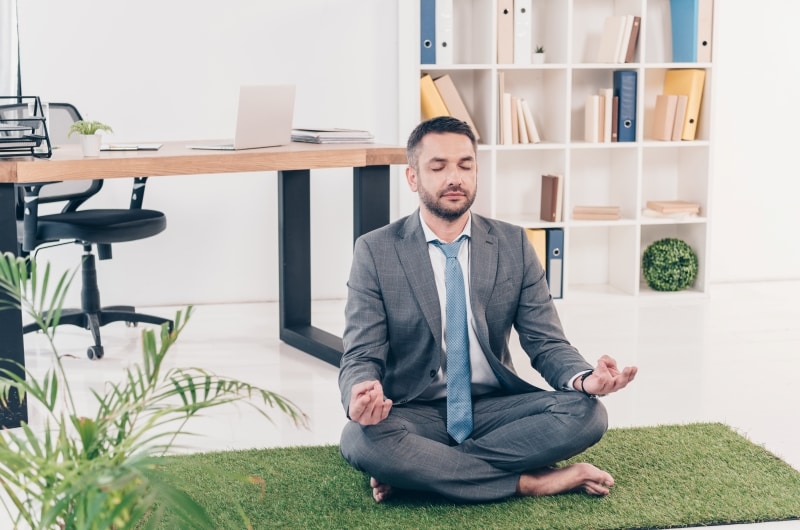Mindfulness has always been an antidote to mental health. Since time immemorial, therapists have been recommending a mindfulness practice to their patients who suffer from depression or anxiety.
Addressing mental health issues is not just taking antidepressants, downers, uppers, or other medication. The doctor recommends a small to a 360-degree turn in daily habits including working out regularly, sleeping the right amount of hours, journalling, and yes, dedicating, at the very least, five minutes of the day to meditation. These small habits have the power to change one’s life completely.

Defining Meditation
Many people have different ideas of what meditation is, and understandably so. Even the experts or main practitioners don’t have the same definition of it. But for the founder of meditation app Headspace Andy Puddicombe, meditation is training in awareness to get a healthy sense of perspective. Meditation teaches a practitioner to observe one’s thoughts without judging which leads to a better understanding of the mind, how it thinks and processes its thoughts.
Mindfulness, the ability to be fully present, is practiced in meditation. Anxious thoughts are often caused by traumatic experiences from the past and irrational worries about the future. In mindfulness, people are reminded to focus on the here and now, to take things one step at a time, and to control feelings and behavior at the present moment.

Why Meditate
Research has proven time and again that meditation aids in sharpening focus and realigning the way we perceive our negative thoughts. When meditation becomes a regular practice, we learn to control the impact of our negative emotions, not allowing them to take a hold of ourselves and our life decisions. Being mindful of the present makes us calmer individuals with clearer and more focused minds.
For example, Angel is hosting a dinner for friends that she decided to make pasta from scratch. She could worry about what her guests would say about her space or their thoughts on the dinner she prepared but her regular meditation practice has trained her not to. Instead of entertaining these negative thoughts, she would shift her focus to her task at hand, roll the dough into perfection and shred it to the right thickness and width before she proceeds to make her homemade sauce.
Studies have also shown that regular meditation helps in lessening anxiety, managing blood pressure, calming down stress hormones, increasing pain tolerance, and getting better quality sleep.

Why Meditate in the Workplace
People spend the bulk of their lives in the workplace. After more than 20 years of studying, they would spend the rest of their lives working for eight hours and five days a week in the office. We deal with people of varying personalities, serve as a boss, interact with our colleagues, and work hard to meet our clients’ needs. In such a high-pressure environment, the workplace isn’t always the most ideally sound environment, especially if we feel burnout and unfulfilled or left out from our colleagues.
Headspace named these four benefits of using meditation in the workplace: (1) reduced stress; (2) improved focus and productivity; (3) Teamwork; and (4) Increased job satisfaction and engagement.
Science has proven that meditation helps in rewiring our brains to have a better stress response. By becoming regular practitioners, we become better at regulating our emotions, solving our problems, and improving our memory and learning capabilities. Being more mindful and focused at present helps us be more efficient and productive at work.
The pandemic has put mental health in focus even more. Big corporations such as Google, General Mills, Intel, Aetna, and Goldman Sachs have been using mindfulness and mounting meditation programs for their employees. Headspace, for instance, met a more than 500% increase in interest from companies who wanted a healthier and better workplace for their employees.

How to Meditate in the Workplace
1. Set a quiet area for meditation.
Don’t go looking for a perfect area. Your workstation may already be the best for your meditation practice because you have the corner all to yourself. Cancel out the sounds around you and focus on the voice instructions of your guided meditation instead. Put your standing desk on sitting height and rest on your gaming chair.
It helps if your workstation is clutter-free. To ensure it’s clean, use storage units that allow you to compartmentalize your desk essentials and office equipment in one place. You may also use the cleaning time as your meditation break.
2. Set the time of day and the amount of time for meditation.
Committing to a daily habit is a hefty task but if you begin now and meditate daily, what began as a chore will eventually become almost instinctive to you. The length of your meditation in a day doesn’t matter but it helps to set how long to make a habit out of it. Decide how long you will meditate in a day, choosing a time limit that won’t become so daunting for you, you might quit the next day.
3. Turn off notifications or uninstall apps.
Get rid of distractions including e-mails and messages from your boss and teammates during your meditation practice. After all, you’ll just be meditating for 15 minutes or less. Check them after your meditation practice because right now, your goal is to close your eyes and focus on your breath for the next 15 minutes.
4. Sit comfortably.
Your body must be in a relaxed position, feet to the ground, hands on the lap, back upright. The massage gaming chair of Flexispot allows one to sit comfortably with padded armrests, cushioned seats, and neck and back support.
You may also opt to sit down on the floor or carpet in an Indian-style seating position. Gently put your hands on each side and look at your environment with a soft stare, not gazing at anything in particular.
5. Close your eyes.
Not seeing your direct environment helps you focus on your breath, how deep and fast it is, and how tense or relaxed your body feels.
6. Scan your body.
Start from the top of your head, ending at the tip of your toenails. Do it multiple times until you can do it slowly. If you lose focus, just return to the body part where you paused and slowly scan again.
7. Count from 1-10 while focusing on your breath.
Count the rising and falling of your breath---inhale, exhale. If you lose count or focus, start from the top. Touch your belly if it helps and feel your body contract and expand.
8. Do it consistently.
Sometimes showing up is the hardest and bravest thing to do. Meditation sounds overwhelming especially for those who are depressed but it was never meant to be practiced with perfection. It’s an exercise for the mind, akin to muscle training that has to be done regularly to enjoy the benefits.
So if the only thing you were able to do today is to show up, be proud of yourself because the battle has been half-won!